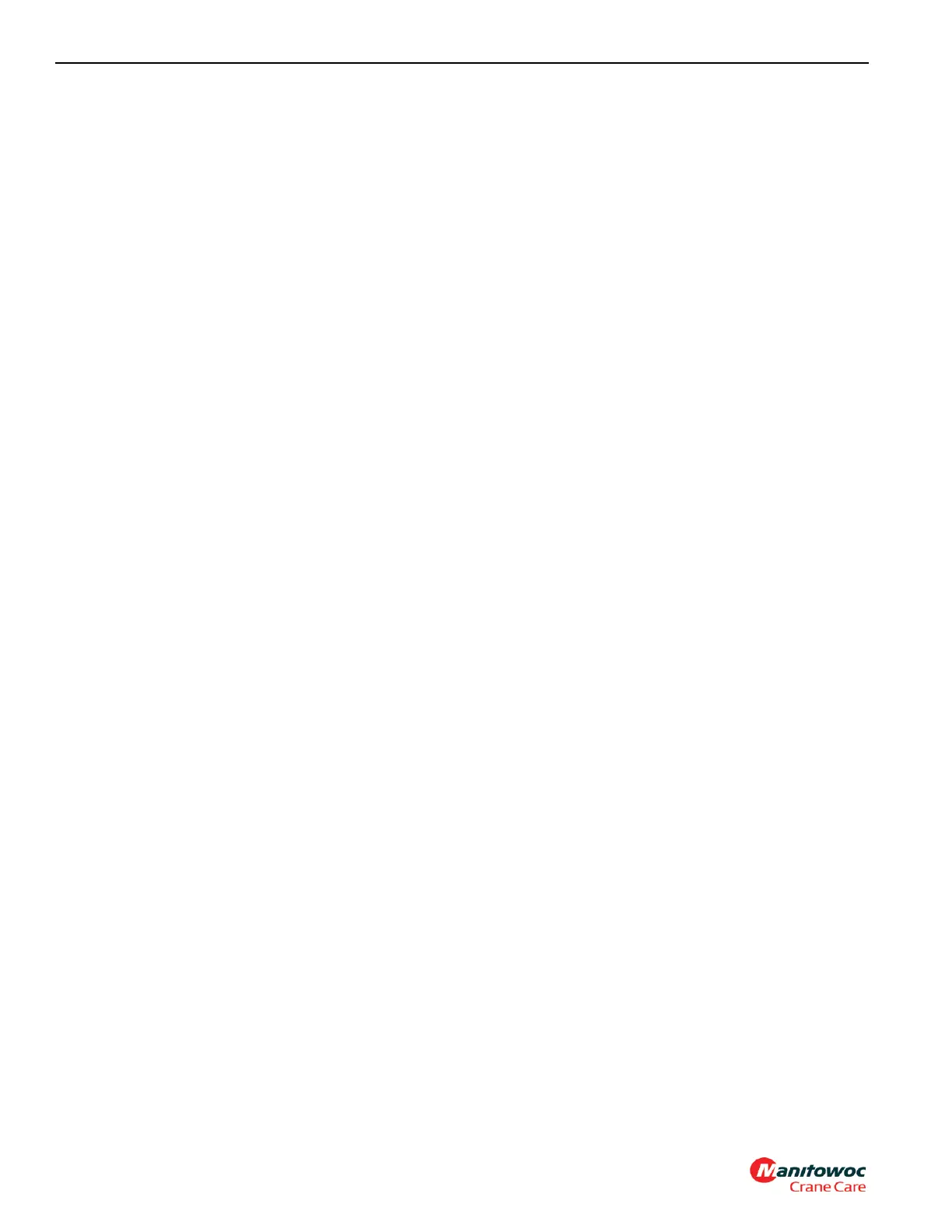POWER TRAIN RT880E SERVICE MANUAL
7-8 Published 11-10-2014, Control # 524-00
Injection Fuel Pump
The fuel is finely atomized as it is injected into the cylinder
and ignited by the heat of compression. It is metered during
injection, to meet the load requirements imposed upon the
engine. Surplus fuel, returning from the injectors, is
bypassed back to the fuel tank or to the inlet side of the
pump. The continuous flow of fuel through the injectors helps
to cool the injectors and to purge air from the system.
Fuel Filter-Water Separator
The fuel filter-water separator removes impurities from the
fuel and also removes water from the fuel before it reaches
the engine. The filter is mounted to the hydraulic oil cooler
bracket on the left side of the crane.
The fuel mixture passes through the outer wrap of the first
stage of the filter paper, where large droplets of water are
formed as it is stripped from the fuel. The water falls out into
the void between the two paper elements and goes to a
reservoir in the bottom of the housing, where it can be
drained through a drain plug at the bottom of the housing.
The water in fuel sensor is located in the fuel filter housing on
the right side of the crane. Once the storage space in the
bottom of the filter housing fills with a certain amount of
water, the sensor will signal the ECM. The Engine Warning
light will illuminate at the operator controls, indicating that the
water should be drained from the fuel filter assembly.
Maintenance
NOTE: The entire fuel system must be maintained air tight
to prevent loss of prime.
Fuel Tank
The fuel tank should be kept filled, especially overnight, to
reduce condensation to a minimum. Refer to the applicable
engine manual for the recommended schedule for draining
any water or sediment from the tank.
Removal
1. Position a suitable container under the fuel tank and
drain all fuel from the tank.
2. Tag and disconnect the two lines from the bottom of the
tank.
3. Disconnect the electrical lead from the fuel quantity
sender unit.
4. Support the weight of the tank, loosen and remove the
capscrews and washers securing the straps to the
mounting brackets. Remove the tank and steps.
5. If a new tank is to be installed, remove the two fittings,
the fuel quantity sender, and steps from the tank and
install them in the new tank.
Installation
1. Position the new tank on the mounting brackets and
install the capscrews and washers on the two straps.
Torque capscrews; refer to Fasteners and Torque Val-
ues, page 1-15 for proper torque value.
2. Connect the electrical lead to the fuel quantity sender
unit.
3. Connect the two lines to the fittings on the bottom of the
tank in accordance with the identification marks made
during removal.
4. Service the tank.
Fuel Filter-Water Separator
Draining
The sump of the fuel filter-water separator should be drained
daily, 30 minutes after the engine is shut down, to remove
any water and sediment. Adhere to the following procedure.
1. Open the drain plug.
2. Drain until fuel appears.
3. Close the drain plug.
AIR INTAKE AND EXHAUST SYSTEM
Description
The air intake system (Figure 7-3) controls the quality and
amount of air available for combustion. System components
are the Air Cleaner, Turbocharger, Charge Air Cooler,
Cylinder Head, and Exhaust Gas Recirculation. Inlet air is
pulled through the Air Cleaner, compressed and heated in
the compressor side of the Turbocharger. The air is pushed
through the Charge Air Cooler to the Air Inlet Manifold.
Cooling the inlet air increases combustion efficiency, lowers
fuel consumption, and increases the horsepower. The air is
forced into the cylinder head to fill the inlet ports. Air flow
from the inlet port into the cylinder is controlled by the intake
valves.
Each cylinder has two intake valves and two exhaust valves.
When the intake valves open, cooled compressed air from
the inlet port is pulled into the cylinder. The intake valves
close and the piston begins to move up on the compression
stroke. Fuel is injected into the cylinder and combustion
starts. The piston is forced down and is on the exhaust stroke
when it moves up again. The exhaust valves open and
exhaust is expelled through the exhaust port into the exhaust
manifold.
The exhaust gas from the exhaust manifold enters the
turbine side of the turbocharger and causes the turbine to
turn driving the compressor. Exhaust from the turbocharger
passes through the exhaust pipe and into the aftertreatment
system and into the atmosphere.
